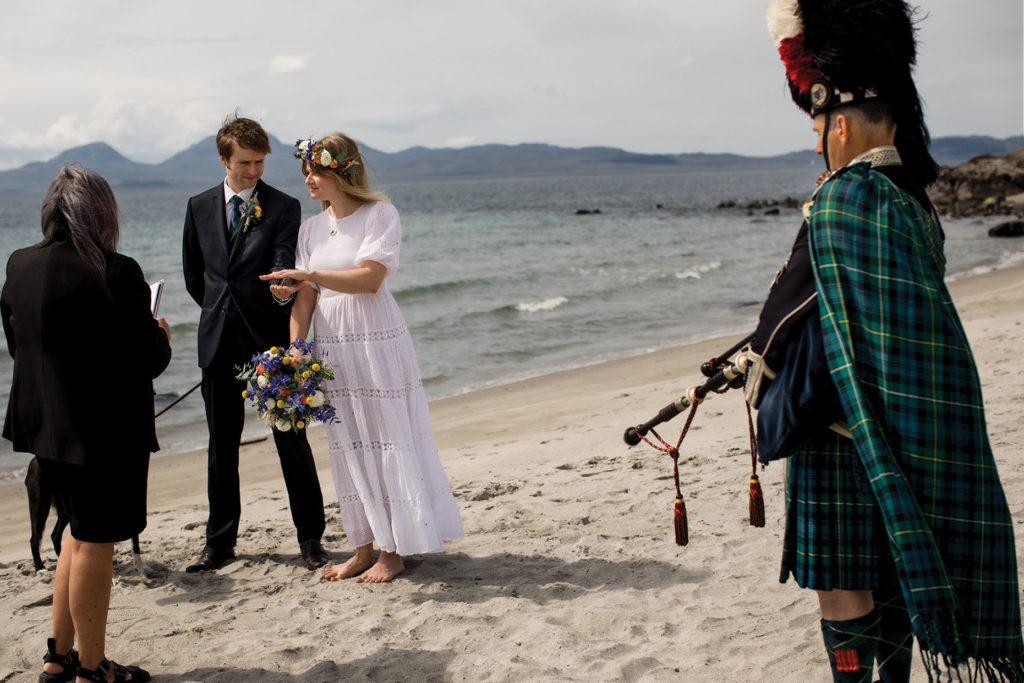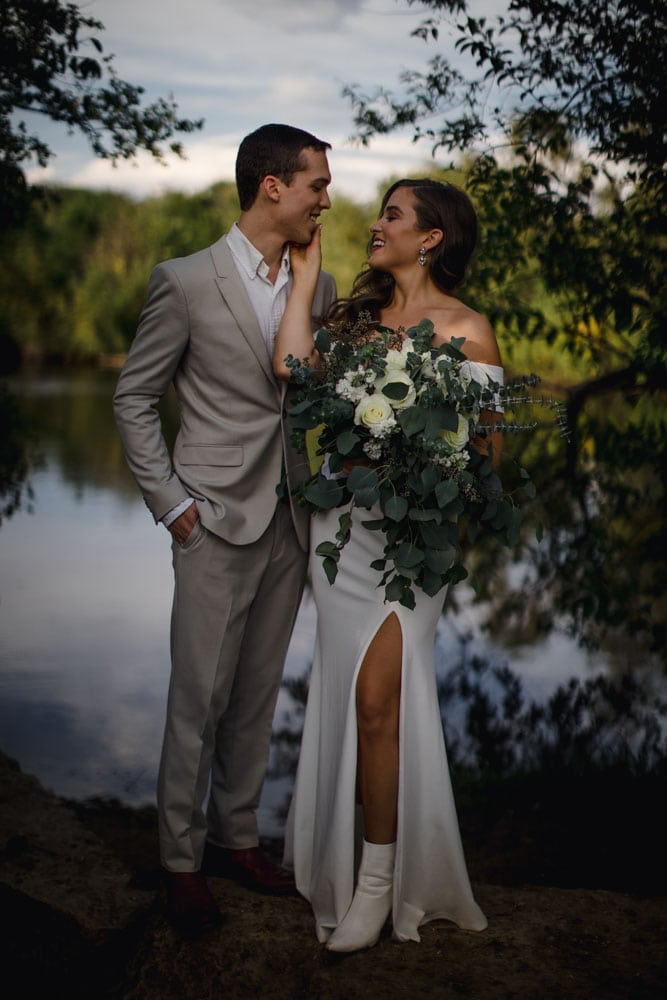There are numerous ways for a couple to commit their lives together, and one of those ways is through a commitment ceremony.
What is a Commitment Ceremony?
A commitment ceremony is practically identical to a wedding, where two people declare their commitment and love for one another and exchange vows. Unlike a traditional wedding, the only difference is that a commitment ceremony is not legally binding.
There are no restrictions on commitment ceremonies whatsoever; you can have a friend sing your vows with you, there’s no need for a civil officiant or judge, and you can even self-solemnize in many states.
Historically, couples in a domestic partnership who couldn’t legally get married by the state or the church due to their race or sexual orientation often chose a commitment ceremony. Nowadays, many couples take this route to bind themselves to one another without taking the legal steps that marriage requires.
Why are Commitment Ceremonies Popular?
There are many reasons why modern couples still choose commitment ceremonies over legally-recognized marriages. First, in many countries across the world, same-sex marriage is still not an option. As of today, only 34 countries legally recognize same-sex marriage.
Another important reason that explains the popularity of commitment ceremonies is that the legal part of marriage interferes with what they want to do on the day of their ceremony. For instance, some states require you to get an ordained officiant or witness at the wedding.
A commitment ceremony is far better if you want it to be only the two of you. Similarly, a commitment ceremony may be the way to go if you can’t get a marriage license in time or don’t want to be legally bound together for tax purposes identical to a wedding, where two people declare their commitment and love for one another and exchange vows. Unlike a traditional wedding, the only difference is that a commitment ceremony is not legally binding.
There are no restrictions on commitment ceremonies whatsoever; you can have a friend sing your vows with you, there’s no need for a civil officiant or judge, and you can even self-solemnize in many states.
Historically, couples who couldn’t legally get married by the state or the church due to their race or sexual orientation often chose a commitment ceremony. Nowadays, many couples take this route to bind themselves to one another without taking the legal steps that marriage requires.
Benefits of Having a Commitment Ceremony Vs Wedding
Commitment ceremonies bring along a host of benefits, such as:
Ease of getting married whenever and wherever
In a commitment ceremony, you don’t have to worry about finding witnesses or an officiant or following the laws while keeping in mind a wedding date. If you can travel to a specific destination, you can express your vows there. If your state has a waiting period, but you don’t want to wait, you can have a commitment ceremony. It’s really that simple.
You don’t have to worry about the complex paperwork.
If dealing with legal paperwork even on your wedding day sounds like a lot, you don’t have to if you opt for a commitment ceremony.
You can perform the ceremony using language that holds meaning for you.
Getting legally married normally requires specific step-by-step instructions or formalities that might not feel personal to you or your partner. For commitment ceremonies, there’s no script, and you can add any details to your vows as you please. If you want your best friend, cousin, or cat to be the one standing with you during the ceremony
How to Plan a Commitment Ceremony?
Planning a commitment ceremony is not much different from planning a traditional wedding or elopement ceremony – except you’d have to worry about fewer things. When planning a commitment ceremony, ask yourself the following questions:
1. Where do you want to get married?
Since there are no hard and fast “rules,” you can go all0in and choose your dream destination.
2. What activities do you want to add?
It’s your day, and you can plan it however you want. So, start by imagining the ideal day for you two and take actionable steps to implement it. Fun activities you can add include sand boarding, hiking, horseback riding, hammocking, hot-air ballooning, cliff jumping, canoeing, whitewater rafting, etc. Discuss with your partner which activities they’d like to indulge in and plan the day around it.
3. Do you want guests?
Similar to “elopement,” you get to decide if you want to invite guests or keep the ceremony exclusive to the two of you. If you decide to invite guests, remember that you will have to make the necessary accommodations.
4. Do you want to self-solemnize or want an officiant?
From a legal standpoint of a commitment ceremony, you don’t have to worry about hiring an officiant. However, it is still a crucial aspect in terms of planning and logistics. Currently, Washington DC and Colorado are the only states where you can self-solemnize with no caveats.
Commitment Ceremony Ideas
If you want to make your commitment ceremony special, here is a list of ideas to choose from.
Elope to your Dream Destination
In traditional terms, elopement is used to describe a legal marriage ceremony conducted secretively, usually away from one’s hometown. It doesn’t always mean that you secretly run away from your family with your lover; it is simply a way to celebrate your union more privately in contrast to a traditional wedding.
A commitment ceremony is a type of elopement that is not legally binding. Elopement ceremonies tend to be simpler than conventional weddings, and commitment ceremonies also follow this simpler path while allowing you to get married out of state.
You can elope with your partner as part of your commitment ceremony anywhere you please and celebrate it intimately. You can travel to another state, rent a cottage in the suburbs, or even travel to another country.
Wear Whatever you Want
Like everything else in a non-traditional commitment ceremony, there are no restrictions on what you wear. There is the freedom to honor or challenge traditions – so if you want to wear a white dress/suit or rock your sweatpants, the choice is yours. Whatever you wear, be intentional about it and own it.
Choose the Season and Time that’s Special To You
Each season has pros and cons – you might feel more drawn to the crispy cold energy of winter or the vibrant tones of summer. Choose a season that fits your kind of love and is special to you and your partner.
Perhaps the two of you met in the summers, or you can’t think of anything better than cozying up by the fire after braving the outside elements.
Also, pick the time of the day that feels the most magical to you and aligns with the rest of your planned activities. This includes sunset, sunrise, high noon, early morning, nighttime, or anything between.
Hand Fasting
Handfasting is a symbolic act done during wedding ceremonies, where the hands of the couple are tied together with a cord, lace, or ribbon to represent their commitment to one another. The hand wrapping represents their love, with music, words, or poetry accompanying the custom.
It has become popular for many commitment ceremonies due to its rich history, visual appeal, and connection to nature.
Make your Traditions or Embrace Local Ones
Depending on where you hold your commitment ceremony, you may want to research local customs and traditions to see if something feels personal. You can honor a place by accepting a local tradition, or you can choose to make your own.
It’s fun to think outside the box and incorporate elements you can replicate later in life. For example, you can get handfasted, renew your vows or revisit a planted tree.
Burn Sage
Burning sage is a powerful ritual that ancient communities have used to clear negative auras for centuries. The sage smudging tradition can occur at any point in your commitment ceremony.
An officiant or a loved one will normally wave the smoke from the sage bundle around you and your partner from head to toe. You may also want to choose an affirmation, intention, or prayer to guide the cleansing to make it more meaningful.
Light a Unity Candle
The lighting of a unity candle is one of the most common customs in both religious and non-religious ceremonies in vow renewals and commitment ceremonies. During the ceremony, the couple takes small candles and ignites the unity candle together.
The fire symbolizes the light of two people to start one life together. If you are having an outdoor wedding ceremony surrounded by trees, it is best to take precautionary steps to prevent the fire from spreading.
Do a Sand Pouring Ceremony
The sand-pouring ceremony is easy and simple yet holds an abundance of meaning. Many couples choose colored sands that match the color of their wedding theme or particular sand from special places they’ve visited.
The sands are then combined into a single container that you can preserve as a keepsake forever. This option is ideal for ceremonies with blended family members and/or children.
Make an Anniversary Capsule
An anniversary capsule is a simple yet beautiful idea that holds an abundance of meaning. During this ceremony, you and your partner can place handwritten love letters for each other in a customized box.
You can also ask your loved ones to write small notes of good wishes and put them in the box. Lock the box after the commitment ceremony and open it on your first wedding anniversary to reminisce about the good times.
Tie a Love Knot
This ceremony involves tying a fisherman’s knot, known as one of the strongest types of knot that don’t break and only grow stronger under pressure. Tying this knot can be confusing, so ensure you and your partner get ample practice beforehand.
Paint a Unity Canvas
A painted canvas is a memorable way to add a splash of color to your commitment ceremony while preserving a unique keepsake for the future. During this enjoyable ritual, each person picks a different paint color and pours it into a blank canvas.
This option is perfect if you or your partner is an art junky. The final masterpiece will express the blending of two hearts, bringing balance and color to each other.
Love Lock
Love locks are a trendy and fun way to seal your commitment to one another. In this ceremony, the couple locks their separate locks together, symbolizing the union of the two souls that cannot be separated.
You can customize the lock to your liking and carve a special message for your partner. The keys are then tossed or tied to helium balloons and released into the air.
Release a Wish Lantern
In this commitment ceremony ritual, the couple releases a paper lantern in the air, allowing their love to transcend the universe as a single unit. Depending on your personality and style, you can customize the lantern.
Commitment Ceremony Script and Personal Vows
If you like, you can make your commitment ceremony vows similar to ones from a wedding ceremony. It can include the following elements:
· Welcoming and greeting the guests
· Readings by the couple or special guests
· Your vows
· Rings exchange
· Proclamation of the commitment
· First kiss
· Conclusion of the commitment ceremony
Conclusion
A commitment ceremony is a magical way for couples to proclaim their love for one another without worrying about the added stress of traditional weddings. You have the freedom to add your rituals, dress however you like, and customize your guest list. Plus, there are no legal formalities or legal paperwork involved. Use the ideas above to make your big day a spiritually monumental one.
Couples that might want to consider a commitment ceremony instead of a legal wedding ceremony
–Polyamorous individuals. A commitment ceremony can recognize the multiple relationships involved, this can include individuals that practice polygamy among members of fundamentalist Mormon churches.
-Couples that would become financially disadvantaged by a legal marriage.
– Same sex couples that are in a country that does not recognize gay marriages.
-Couples that reside in a country that they do not have legal citizenship in.
-Couples that have already been married and want to reaffirm their commitment with one another. This type of commitment ceremony is common when the couples now have children that they want to include within their ceremony.
-Couples that do not want to the constraints of the government in their marriage.
-Couples that do not want a legally binding marriage.
How to Include Friends, Family, and Children in a Commitment Ceremony-
Have your friends and family write letters to the couple for them to read before or after the ceremony. This is fun for the couples to open them on their honeymoon and allows the couple to relive the moments of their commitment ceremony.
If you are including your children in your commitment ceremony, consider including vows to them. It’s amazing to see their faces light up when they are incorporated into the ceremony.
Consider releasing lanterns into the sky at twilight either during or after the commitment ceremony with friends and family.







One Response